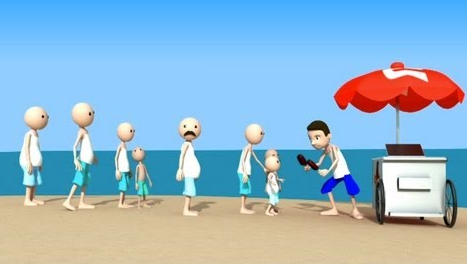(单词翻译:单击)
Why are gas stations always built right next to other gas stations?
为什么加油站旁边总是建另一个加油站?
Why can I drive for a mile without finding a coffee shop and then stumble across three on the same corner?
为什么我开了一英里的车还是没有找到咖啡店,然后偶然发现有三家店竟然在同一个角落
Why do grocery stores, auto repair shops and restaurants always seem to exist in groups
为什么食品杂货店,汽车修理店和饭店似乎经常以抱团的形式存在
instead of being spread evenly throughout a community?
而不是被分开,甚至是在同一个社区?
While there are several factors that might go into deciding where to place your business,
有一些因素或许决定你在哪里做生意,
clusters of similar companies can be explained by a very simple story called Hotelling's Model of Spatial Competition.
相似商户的成群出现可以解释为一个很简单的理论,叫做豪泰林的空间竞争模型。
Imagine that you sell ice cream at the beach.
假设你在沙滩上卖冰激凌。
Your beach is one mile long and you have no competition.
你的沙滩长达一英里且没有竞争对手。
Where would you place your cart in order to sell the most product? In the middle.
为了卖出更多冰激凌,你会把摊位摆在哪?在中间。
The one-half-mile walk may be too far for some people at each end of the beach, but your cart serves as many people as possible.
半英里对于沙滩边的人而言可能已经很远了,可你的摊位要有越多人买才好。
One day you show up at work just as your cousin Teddy is arriving at the beach with his own ice cream cart.
有一天你来到工作的地方,正好你的表亲泰迪也刚到这片沙滩,推着他的冰激凌小摊。
In fact, he's selling exactly the same type of ice cream as you are.
事实上,他正在卖的恰恰是同你同样口味的冰激凌。
You agree that you will split the beach in half.
你想尝试把沙滩一分为二。
In order to ensure that customers don't have to walk too far
为了让顾客不用走太远,
you set up your cart a quarter mile south of the beach center, right in the middle of your territory.
你把摊位摆在离沙滩中间往南四分之一英里处,正好是在你所在领域的中间。
Teddy sets up a quarter mile north of the center, in the middle of Teddy territory.
泰迪的摊位则设在沙滩中心往北四分之一英里的地方,他所在的地带的中心。
With this agreement, everyone south of you buys ice cream from you.
达成一致后,来自你南边的每个人就从你这里买冰激凌。
Everyone north of Teddy buys from him, and the 50% of beachgoers in between walk to the closest cart.
来自北边的就去泰迪那买,在沙滩上有50%的人是就近买。

No one walks more than a quarter of a mile, and both vendors sell to half of the beachgoers.
没有人走超过四分之一英里的路程,两个摊位都卖出一半冰激凌给沙滩上的人。
Game theorists consider this a socially optimal solution.
博弈论理论家认为这是一个社会最优方案。
It minimizes the maximum number of steps any visitor must take in order to reach an ice cream cart.
它尽可能减少了游客需要走到冰激凌摊位的最多步数。
The next day, when you arrive at work, Teddy has set up his cart in the middle of the beach.
第二天,你来到工作摊位时,泰迪已经把他的摊位移到沙滩中间。
You return to your location a quarter mile south of center and get the 25% of customers to the south of you.
你回到离沙滩中心四分之一英里的摊位,只获得了来自南边的25%的客人。
Teddy still gets all of the customers north in Teddy territory,
泰迪还是得到所有北边的顾客,
but now you split the 25% of people in between the two carts.
但你却流失了25%的客人。
Day three of the ice cream wars, you get to the beach early, and set up right in the center of Teddy territory,
在第三天的冰激凌竞争中,你早早来到沙滩,刚好摆在泰迪领域的中心,
assuming you'll serve the 75% of beachgoers to your south, leaving your cousin to sell to the 25% of customers to the north.
想着你将获得来自南边的75%的顾客,给你的表亲留下了来自北边的25%的顾客。
When Teddy arrives, he sets up just south of you stealing all of the southerly customers,
泰迪来后就摆在你的南边,偷走了所有南边的顾客,
and leaving you with a small group of people to the north.
你只得到了一点点北边的顾客。
Not to be outdone, you move 10 paces south of Teddy to regain your customers.
你也不甘落后,往南向泰迪移动十步重新获得原来的顾客。
When you take a mid-day break, Teddy shuffles 10 paces south of you,
泰迪趁你午休时又往南搬离你十步,
and again, steals back all the customers to the far end of the beach.
再次偷回所有来自沙滩尽头的顾客。
Throughout the course of the day, both of you continue to periodically move south towards the bulk of the ice cream buyers,
经过这一天,你们一直时不时往南移动,到有大量顾客的地方,
until both of you eventually end up at the center of the beach, back to back, each serving 50% of the ice-cream-hungry beachgoers.
直到最后你在沙滩中心停下来,来来回回后,每人得到一半顾客。
At this point, you and your competitive cousin have reached what game theorists call a Nash Equilibrium -
至此,你和你的泰迪表兄已经达到博弈论学家所说的纳什均衡
the point where neither of you can improve your position by deviating from your current strategy.
你不能通过移动你的位置来获取更高的利益了
Your original strategy, where you were each a quarter mile from the middle of the beach, didn't last, because it wasn't a Nash Equilibrium.
你原先的策略是你们都在离沙滩中心四分之一英里的地方,但是好景不长,因为那不符合纳什均衡理论。
Either of you could move your cart towards the other to sell more ice cream.
你们各自都可以移动位置以卖出更多的冰激凌
With both of you now in the center of the beach,
现在你们两个都在沙滩的中心,
you can't reposition your cart closer to your furthest customers without making your current customers worse off.
你无法移动位置来节省最远的顾客要走的路程,而不使得你的当前客户需要走的路程加长。
However, you no longer have a socially optimal solution,
可是,你不再有社会的最优选择,
since customers at either end of the beach have to walk further than necessary to get a sweet treat.
因为沙滩每一边的顾客都必须走比原来所需更远的路程才能尝到一份甜品。
Think about all the fast food chains, clothing boutiques, or mobile phone kiosks at the mall.
想想所有的快餐连锁店,服装精品店或者商场的移动电话亭。
Customers may be better served by distributing services throughout a community,
如果服务分布在整个社区,顾客可能会得到更好的服务,
but this leaves businesses vulnerable to aggressive competition.
但是这使企业受到激烈的竞争
In the real world, customers come from more than one direction,
在现实生活中,顾客来自四面八方,
and businesses are free to compete with marketing strategies, by differentiating their product line, and with price cuts,
并且企业之间用营销策略自由竞争,通过差异化他们的产品线和降价,
but at the heart of their strategy, companies like to keep their competition as close as possible.
但其实他们的核心策略是,企业要尽可能的保持自己的竞争力。


